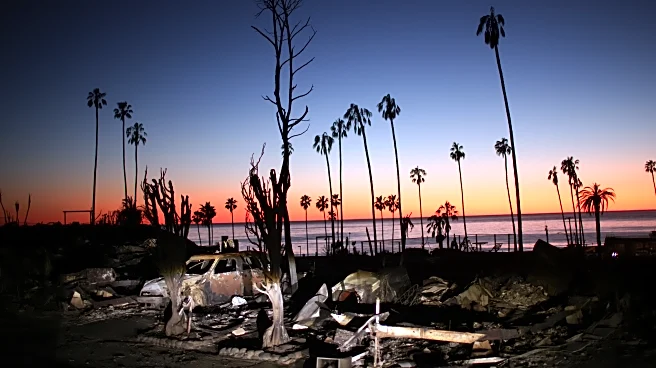What's Happening?
California has experienced its first major storm of the season, bringing significant precipitation to the state. This storm, classified as a weak atmospheric river, has transformed the state's mountain
peaks with snow and filled reservoirs with rain. The deluge has left nearly all of California's major reservoirs at or above historical levels for this time of year. The storm has also delayed the fire season in Los Angeles, potentially for weeks or months, according to experts. Satellite photos from the National Oceanic and Atmospheric Administration show the dramatic change in the landscape, with brown peaks turning snow-capped and greener landscapes appearing statewide. Marty Ralph, director of the Center for Western Weather and Water Extremes at UC San Diego, noted that the moisture absorbed by trees, grasses, and plants will make them less prone to burning, providing a temporary reprieve from fire risks.
Why It's Important?
The storm's impact is significant for California, a state that has been grappling with severe drought conditions. The replenishment of reservoirs and the delay in fire season are crucial for both environmental and economic reasons. The moisture helps mitigate the risk of wildfires, which have been increasingly destructive in recent years, threatening homes, wildlife, and air quality. Additionally, the improved water levels in reservoirs are vital for agriculture, urban water supply, and ecosystem health. This development offers a positive start to the water year, potentially easing the strain on water resources and reducing the need for stringent water conservation measures.
What's Next?
The storm sets a favorable precedent for the upcoming winter season, with hopes for more atmospheric river events to further alleviate drought conditions. Continued monitoring of reservoir levels and fire risks will be essential. Stakeholders, including government agencies and environmental groups, will likely focus on strategies to capitalize on the increased water availability while preparing for potential future droughts. The state's response to this storm could influence water management policies and fire prevention strategies in the coming months.
Beyond the Headlines
The storm highlights the importance of atmospheric rivers in California's climate system, which can bring both beneficial and hazardous impacts. While the current storm has provided relief, it also underscores the state's vulnerability to climate variability and the need for adaptive strategies to manage water resources and fire risks. Long-term shifts in climate patterns could affect the frequency and intensity of such storms, necessitating ongoing research and policy adjustments.












